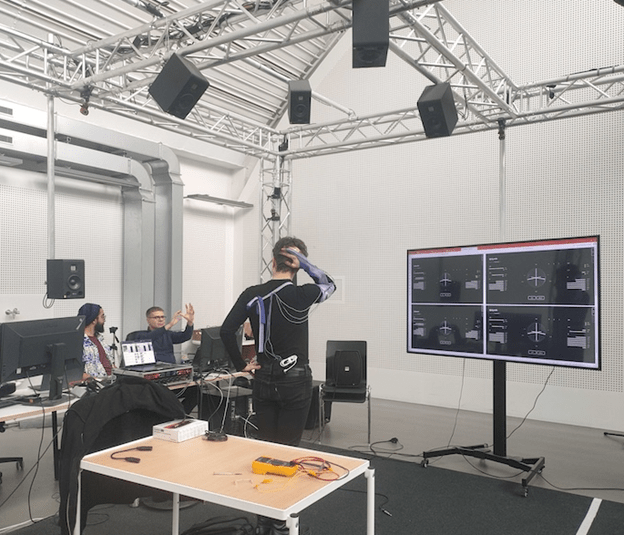
Prof. Eduardo Miranda and the University of Plymouth’s Interdisciplinary Centre for Computer Music Research (ICCMR) have performed two SOLD OUT quantum concerts. The significance of this is fivefold: 1) people are curious about music with quantum computers and want to know more, 2) they’re willing to pay to listen to it, 3) there’s enough demand to sell out the tickets in advance, 4) the first performance had a queue outside, hoping to get in, and 5) the second performance received a standing ovation.
The first concert was “Concert Quantum Tunes: Mind and Wiggle,” held on January 30, 2024, at the Einstein Center Digital Future (ECDF), an interdisciplinary project of Technische Universität Berlin, Charité – Universitätsmedizin Berlin, Freie Universität Berlin, Humboldt-Universität zu Berlin and Universität der Künste Berlin. The second concert was “Wave Dysfunction,” held on February 2, 2024, at the CTM Festival, an annual “festival and platform for adventurous music and art” in Berlin.
Music as an Application of Quantum Computing
It is important to note that the audiences did not watch some programmer sitting at a desk typing Python instructions into a Jupyter notebook. One of the key words in the title of this article is “concerts.” Like you would expect to see at any concert, there were instruments and there were performers. What made these concerts special was the involvement of a quantum computer.
The two projects on stage were Q1Synth and QuPoly, and they used the quantum computer differently.
Q1Synth Concerts
Q1Synth is a musical instrument that is played either with gestural controllers or brain-computer music interfaces. The performer physically or mentally manipulates quantum states that are visualized on a screen, putting the qubits into superposition and even entangling them. The quantum circuit is submitted via the cloud to an IQM quantum computer in Finland that measures the qubits and returns the results to Q1Synth. The measurements are then rendered as sound via analog synthesizers.
To add complexity, multiple performers can gesticulate or contemplate on behalf of different instruments at the same time. The measurements returning from IQM are rendered as the ensemble of instruments.
Before moving on to QuPoly, the brain-computer music interface deserves some extra attention. There are performers, tragically, who lose the physical ability to perform due to the sustainment of traumatic injuries. With this interface, it becomes possible for them to play once more.

Diagram of the QuSynth process which involves a quantum computer software interface with an instrument player
QuPoly
QuPoly uses a quantum generative algorithm to compose new music. Now, you’re probably thinking that we can’t do anything useful with quantum computers and this must be hype. But the one thing that we CAN do with quantum computers is generate random numbers. Of course, if we composed music with completely random notes it would sound awful. Fortunately, quantum computers don’t have to generate completely random numbers.
As the performers play their instruments, the sound is digitized and encoded. A classical algorithm then analyzes the data and determines the “rules” of what they were playing. In other words, if we have a sequence of notes, what did the performers play after that sequence? And if the sequence was played multiple times, how often did the performers play each of the following notes?
Imagine we have a sequence of notes A-B-C. This sequence was played 10 times. Three times a D was played next, two times an E was played next, and five times an F was played next. We tell the IQM quantum computer that we don’t want perfectly random numbers, we want a 30% probability of measuring 011 (representing D), a 20% probability of measuring 100 (representing E), and a 50% probability of measuring 101 (representing F). The quantum computer “decides” what comes next in our new composition. Because the “rules” come from the performers, the new composition does not sound like random noise. In fact, it usually resembles the original to some degree, at least in parts. After all, there are probabilities for generating familiar sequences as well as probabilities for generating original sequences.
Conclusion: The Future of Quantum Concerts?
Pioneered by Prof. Miranda, music is a legitimate application of quantum computing. This article only scratches the surface of his research; a history of computer music and more information about Q1Synth and QuPoly can be found in the article “Quantum Computer Music. What the heck?,” written by Prof. Miranda in December 2023. There is a growing community of quantum music enthusiasts, and these two examples are far from the only ones.
Disclosure
The author contributed to QuSing, the predecessor of QuPoly. QuSing worked with pre-recorded music; QuPoly added the ability to “listen” in real-time to live performers.
Brian N. Siegelwax is an independent Quantum Algorithm Designer and a freelance writer for Inside Quantum Technology. He is known for his contributions to the field of quantum computing, particularly in the design of quantum algorithms. He has evaluated numerous quantum computing frameworks, platforms, and utilities and has shared his insights and findings through his writings. Siegelwax is also an author and has written books such as “Dungeons & Qubits” and “Choose Your Own Quantum Adventure”. He regularly writes on Medium about various topics related to quantum computing. His work includes practical applications of quantum computing, reviews of quantum computing products, and discussions on quantum computing concepts.
- SEO Powered Content & PR Distribution. Get Amplified Today.
- PlatoData.Network Vertical Generative Ai. Empower Yourself. Access Here.
- PlatoAiStream. Web3 Intelligence. Knowledge Amplified. Access Here.
- PlatoESG. Carbon, CleanTech, Energy, Environment, Solar, Waste Management. Access Here.
- PlatoHealth. Biotech and Clinical Trials Intelligence. Access Here.
- Source: https://www.insidequantumtechnology.com/news-archive/not-hype-sold-out-quantum-concerts-by-brian-siegelwax/



